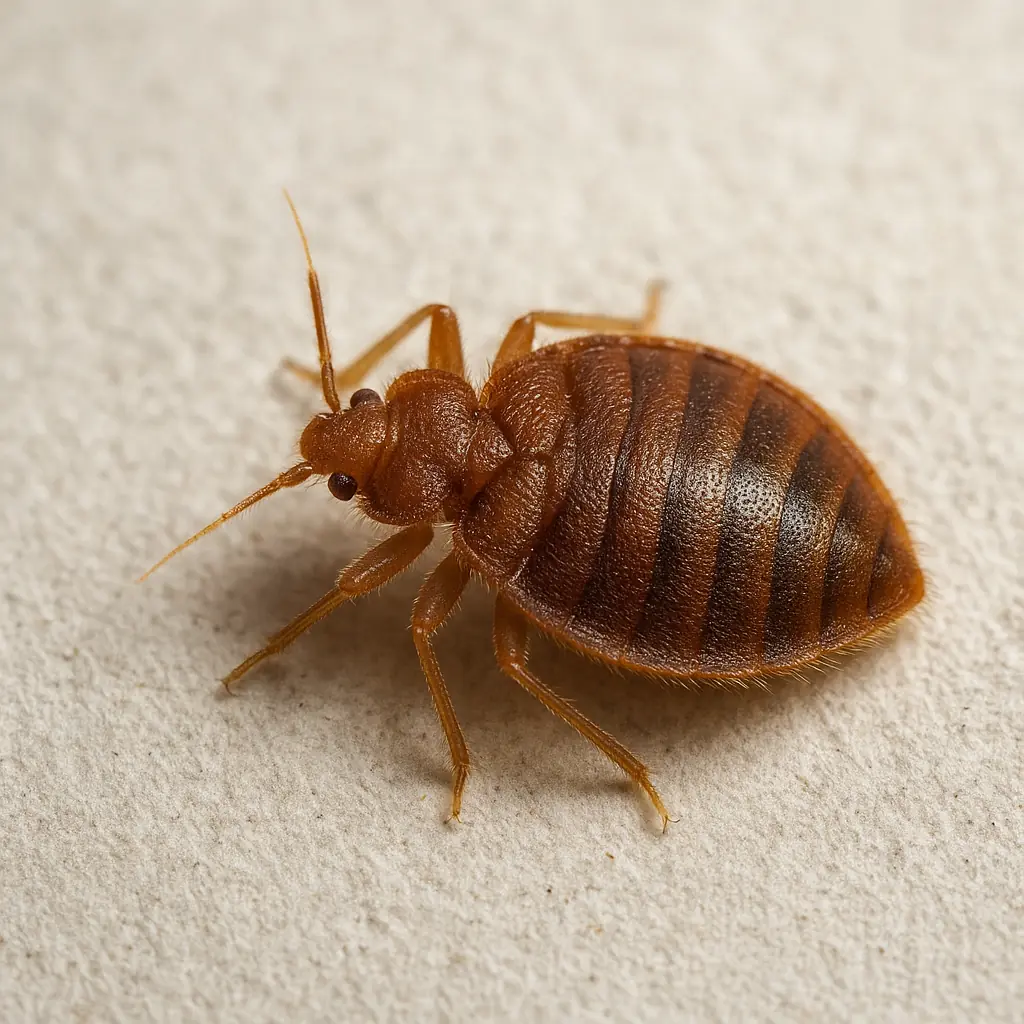
Bed Bug Identification: Complete Visual Guide + Free AI Photo Analysis
Found a suspicious bug crawling across your sheets at 3 AM? Woke up with mysterious bite marks? You’re not alone—bed bug identification challenges affect millions of homeowners yearly, with 97% of pest control professionals reporting recent bed bug treatments. Yet studies show that 73% of people can’t accurately identify bed bugs, leading to delayed treatment and exponential population growth.
This comprehensive guide eliminates the guesswork with professional-grade identification techniques, high-resolution comparison photos, and systematic inspection methods used by pest control experts. Most importantly, you’ll discover our FREE AI-powered identification tool that provides instant professional confirmation within minutes—no appointments, no fees, no waiting.
Have a photo? Get Instant ID
Upload bugs, stains, or shells — get a verdict in minutes.
No photo? Describe the signs
Tell us what you’re seeing — we’ll advise what to check next.
Table of Contents
- What Bed Bugs Actually Look Like
- Bed Bug Life Stages Visual Guide
- Bed Bug Evidence & Signs
- Where Bed Bugs Hide
- Bed Bug Bite Identification
- Bed Bugs vs. Common Look-Alikes
- Professional Inspection vs. DIY Identification
- Systematic Bed Bug Inspection Process
- When to Take Immediate Action
- Frequently Asked Questions
What Bed Bugs Actually Look Like
Adult Bed Bug Characteristics
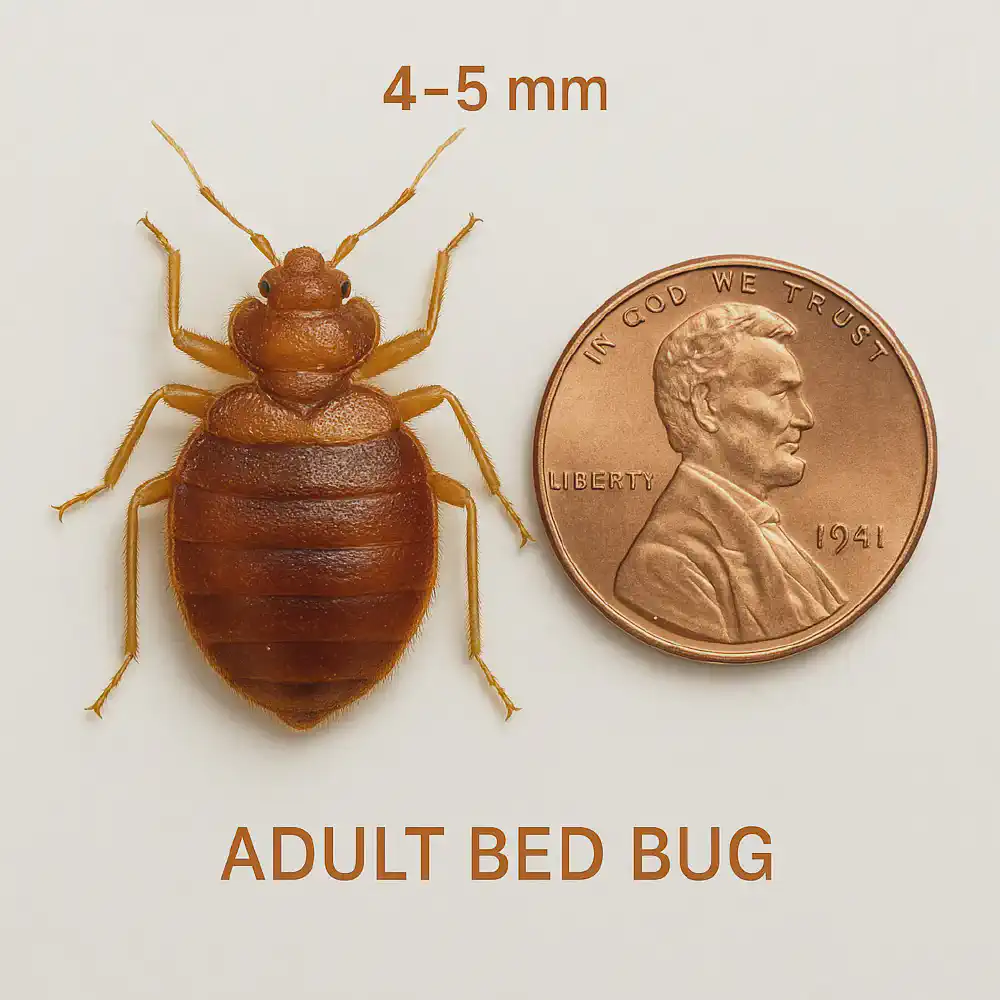
Size: 4-5mm long (apple seed size) - approximately the width of Abraham Lincoln’s head on a penny Shape: Oval, flattened when unfed (like a lentil) to swollen and elongated after feeding (like a small grape) Color: Light brown to reddish-brown, darkening to mahogany or black after blood meals
These traits make adults the easiest life stage to identify. However, younger stages look dramatically different—and missing early-stage identification can mean the difference between a manageable problem and a full-scale infestation. Learn how to identify baby bed bugs in all five nymph stages.
Key Identifying Features
- Six legs with distinct segments and no jumping ability
- Short, golden-colored antennae with 4 segments
- Small head with prominent black eyes
- No wings whatsoever (cannot fly or glide)
- Horizontal ridges across the abdomen (visible under magnification)
- Beak-like proboscis for piercing skin (usually hidden)

Color Variations Throughout Feeding Cycle
Understanding bed bug color changes helps distinguish them from similar pests. See our complete color identification guide for detailed comparisons.
| Feeding State | Color | Appearance | Visibility |
|---|---|---|---|
| Unfed (Hungry) | Light brown to translucent | Flat, thin profile | Easier to spot on dark surfaces |
| Recently Fed | Dark red to almost black | Swollen, elongated | More visible due to size |
| Molting Stages | Yellowish to pale brown | Lighter, sometimes clear | Most difficult to see |
| Crushed/Dead | Dark red-brown | Flat with blood spots | Obvious on light bedding |
How Big Are Bed Bugs Compared to Other Insects?

- Larger than: Fleas (1-3mm), booklice (1-2mm), spider mites (0.5mm)
- Similar to: Ticks (3-5mm), carpet beetles (2-4mm)
- Smaller than: Cockroach nymphs (5-10mm), most beetles (5-15mm)
Got a close-up of the bug?
AI checks size, color, and shape against bed bug traits.
Bed Bug Life Stages Visual Guide

Understanding bed bug development stages is crucial for accurate identification. Missing early stages means missing the opportunity for easier, more affordable treatment. Even if you stop seeing signs of activity, that doesn’t mean the infestation is gone. Bed bugs are known for their ability to survive long periods without feeding — especially in storage units, empty homes, or unused furniture.
Learn exactly how long bed bugs can survive without a host →
Comprehensive Life Stage Breakdown
Eggs (Most Common Evidence)
- Size: 1mm (pinhead size)
- Color: Pearl white, translucent
- Location: Cemented in mattress seams, furniture cracks
- Key identifier: Often found in clusters of 5-20
Five Nymph Stages (1st through 5th Instar)
- 1st Instar: 1.5mm, nearly transparent, extremely difficult to see
- 2nd-3rd Instar: 2-3mm, light brown, becoming more visible
- 4th-5th Instar: 3-4mm, darker brown, clearly identifiable
- Behavior: More active than adults, less cautious during daylight
Get detailed identification photos for each baby bed bug stage.
Adult Bugs (4-5mm)
- Appearance: Dark brown, apple seed-sized
- Behavior: Primarily nocturnal, very secretive
- Location: Deep in furniture cracks and seams
- Identification tip: Most likely to be photographed clearly
Bed Bug Size Progression Chart

| Life Stage | Size (mm) | Comparison Item | Visibility Level |
|---|---|---|---|
| Eggs | 1mm | Pinhead, salt grain | Barely visible, magnification helpful |
| 1st Instar Nymph | 1.5mm | Poppy seed | Extremely difficult with naked eye |
| 2nd-3rd Instar | 2-3mm | Sesame seed | Visible but very small |
| 4th-5th Instar | 3-4mm | Small rice grain | Clearly visible |
| Adult | 4-5mm | Apple seed, lentil | Easily visible to naked eye |
| Engorged Adult | 6-7mm | Small grape | Very obvious |
Molting Evidence and Cast Skin Identification
As bed bugs grow, they shed their exoskeletons five times before reaching adulthood. These shed skins, called cast skins or shells, are often the first evidence homeowners discover. Learn to identify bed bug shells and casings.
Bed Bug Evidence & Signs

Physical evidence often appears before you spot live bugs. Learning to recognize these signs enables earlier intervention when treatment is most effective and affordable.
Visual Evidence You Can Identify
| Evidence Type | What to Look For | Most Common Locations | Significance Level |
|---|---|---|---|
| Blood Stains | Small, rust-colored spots (1-3mm) | Sheets, pillowcases, mattress edges | High – indicates active feeding |
| Fecal Spots | Dark brown/black specks or smears | Mattress seams, bed frame joints | High – digestive waste evidence |
| Shed Skins | Brown, translucent casings | Hiding spots, mattress edges | Medium – molting evidence |
| Eggs/Eggshells | Tiny white specks (1mm) | Cracks, seams, furniture joints | High – active reproduction |
| Sweet Odor | Musty, coriander-like smell | Heavily infested rooms | Medium – large population indicator |
| Live Bugs | Moving insects during day inspection | All hiding locations | Highest – definitive proof |
Early Warning Signs Timeline

Week 1-2 Identification Clues:
- Single bugs found crawling on walls or ceiling
- 1-2 small blood spots on sheets after sleeping
- Dark spots on light-colored sheets
- Faint sweet smell in bedroom
Week 3-4 Identification Clues:
- Multiple blood spots on bedding
- Shed skins found during inspection
- More visible bugs during daytime checks
- Stronger musty odor
Found stains or skins?
Upload sheet photos for evidence analysis.
Not sure it’s evidence?
Tell us what you found — we’ll confirm if it matches bed bug signs.
Where Bed Bugs Hide
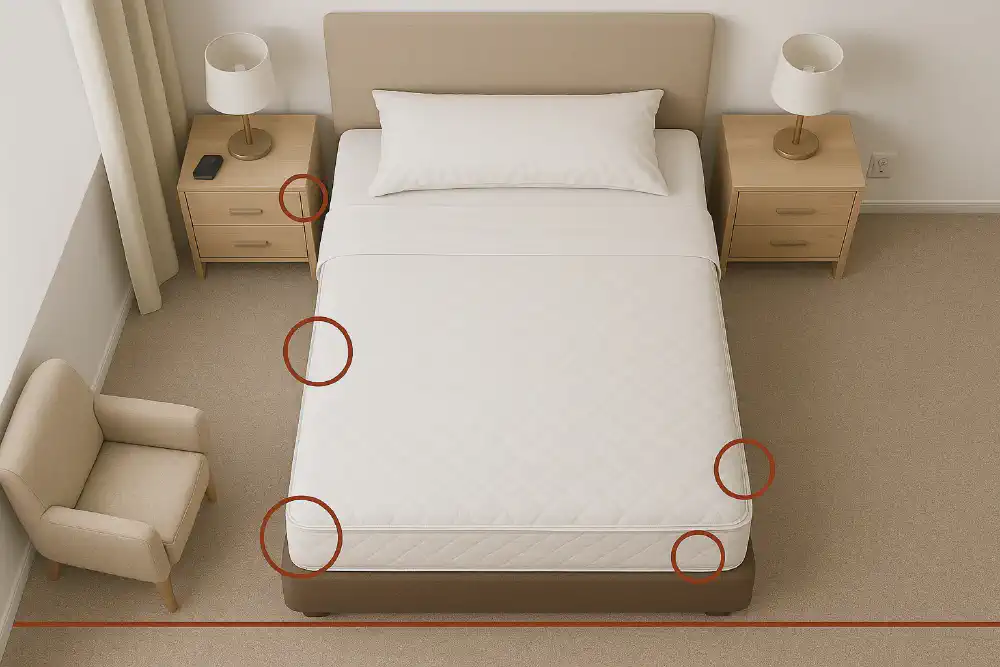
Bed bugs stay within 8 feet of sleeping areas, but their flat bodies allow them to squeeze into cracks as thin as a credit card. Understanding their hiding preferences is essential for accurate identification.
Primary Hiding Locations (Check These First)
Bedroom Priority Inspection Areas:
- Mattress Seams - Focus on head-end corners and along all edges
- Box Spring - Underneath, especially corners and center support beam
- Bed Frame - Joints, screw holes, and any crevices
- Headboard - Wall-mounting brackets and behind the entire board
- Nightstands - Inside drawers, undersides, and back panels
Secondary Hiding Spots
Furniture Areas:
- Upholstered chairs and sofas (seams and cushions)
- Curtains and drapes (especially pleats and hems)
- Picture frames and wall decorations
- Carpet edges and area rugs
- Lampshades and electrical fixtures
Electronic Equipment:
- Alarm clocks and radios near beds
- Laptops and chargers left on beds
- TV stands and entertainment centers
- Phone charging stations
Professional 30-Second Visual Inspection Method
- Pull back sheets and check mattress corners
- Shine phone flashlight along mattress seams
- Look for dark spots (blood or fecal stains)
- Check for sweet, musty odor
- Examine headboard base where it meets the wall
Red Flags: Dark spots, rust-colored stains, sweet smell, or live bugs
Bed Bug Bite Identification
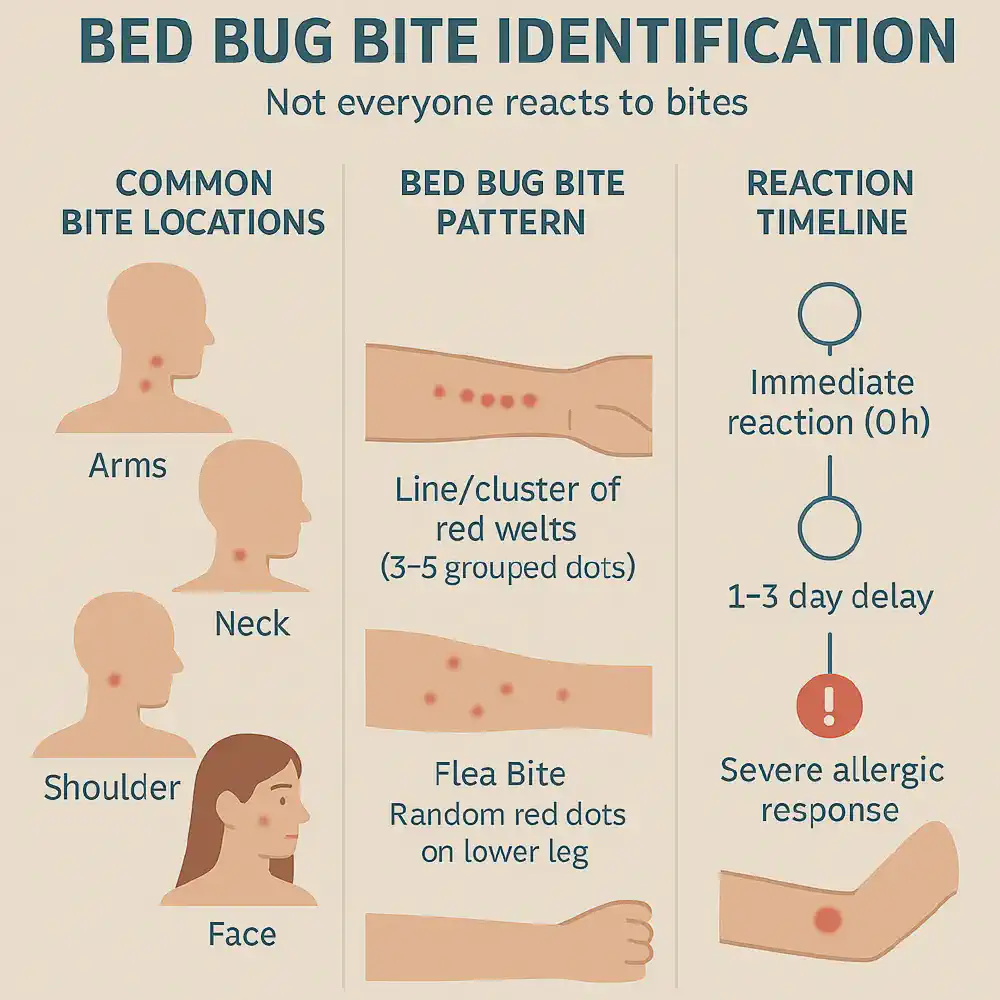
While not everyone reacts to bed bug bites, understanding bite patterns helps confirm identification when combined with other evidence.
Bite Pattern Recognition
Typical Characteristics:
- Pattern: Often in lines or clusters of 3-5 bites
- Timing: Appear 1-3 days after feeding (sometimes immediately)
- Location: Exposed skin during sleep (arms, shoulders, neck, face)
- Appearance: Red, itchy welts that may develop into larger bumps
Individual Reaction Variations
Important Note: 30% of people don’t react to bed bug bites at all. No bite reactions doesn’t mean no bed bugs.
Reaction Timeline:
- Immediate: Some people see welts within minutes
- Delayed: Most reactions develop 1-3 days later
- Severe: Allergic individuals may develop large, inflamed areas
Differentiation from Other Insect Bites
Bed Bug Bites vs. Flea Bites:
- Bed bugs: Upper body, lines/clusters, delayed reaction
- Fleas: Lower legs/ankles, random pattern, immediate reaction
Bed Bug Bites vs. Mosquito Bites:
- Bed bugs: Multiple bites in pattern, persistent itching
- Mosquitoes: Single bites, typically outdoor exposure
Bed Bugs vs. Common Look-Alikes
Accurate identification requires distinguishing bed bugs from insects that share similar characteristics. Misidentification leads to wrong treatment approaches and wasted time.
Most Common Misidentifications

| Feature | Bed Bug | Carpet Beetle | Flea | Tick |
|---|---|---|---|---|
| Size | 4-5mm | 2-4mm | 1-3mm | 3-5mm |
| Shape | Oval, flat | Round, dome | Laterally compressed | Round, engorged |
| Color | Brown to reddish-brown | Brown with patterns | Dark brown/black | Brown to gray |
| Wings/Movement | None, crawls slowly | Yes (rarely fly) | Powerful jumpers | None, crawls |
| Habitat | Beds, furniture | Carpets, fabrics | Pet areas, carpets | Outdoor, on hosts |
Quick Identification Test Questions

Ask yourself these questions when examining a suspicious bug:
- Can it jump? If yes, it’s likely a flea, not a bed bug
- Does it have wings? Bed bugs never have wings
- Is it smaller than an apple seed? Adult bed bugs are apple seed-sized or larger
- Where did you find it? Bed bugs stay within 8 feet of sleeping areas
- What time of day? Bed bugs are primarily active 1-5 AM
Bed Bug Identification Myths Debunked
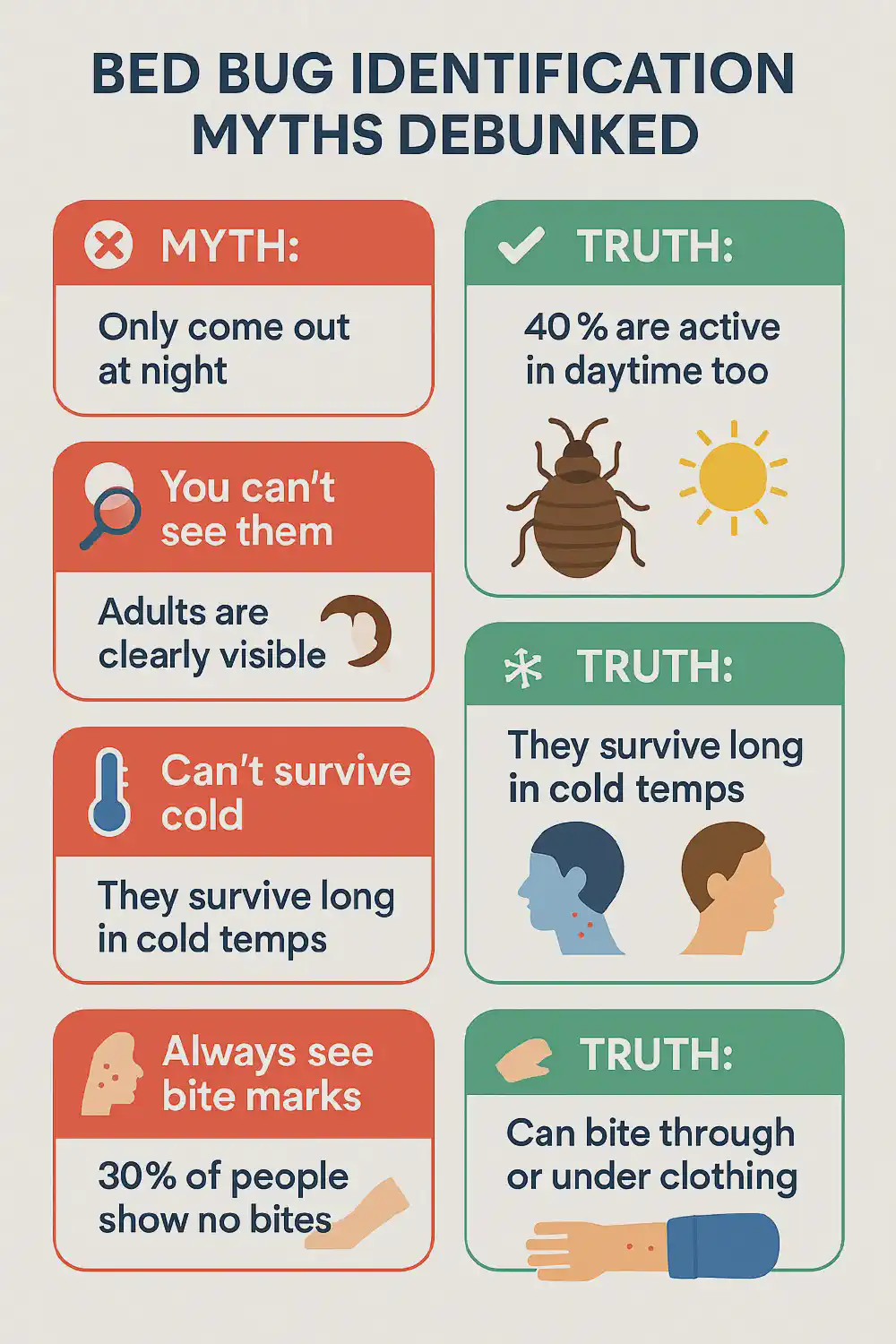
Myth 1: “Bed bugs only come out at night”
While bed bugs are most active at night, they will emerge during the day if they’re hungry — especially in heavily infested spaces. Don’t assume daytime safety!
| Room | Common Hiding Spots | Unexpected Places | Evidence Found |
|---|---|---|---|
| Bedroom | Bed frame joints, mattress tags | Closet areas, window treatments | Shed skins, eggs, sweet odor |
| Living Room | Sofa seams, recliner cushions | Behind TV, picture frames | Dark spots, cast skins |
| Home Office | Desk chair, daybed/couch | Baseboards, electronics | Eggs in cracks, fecal stains |
When to Take Immediate Action
Early identification and rapid response prevent exponential population growth. Bed bugs double their population every 16 days under ideal conditions.
Early Infestation Indicators Requiring Urgent Response
Week 1–2 Warning Signs:
- First live bug sighting (even just one)
- Fresh blood spots on sheets
- New bite reactions in household members
- Faint sweet/musty odor in bedroom
Critical Action Window: The first 2–4 weeks after initial detection offer the best treatment success rates and lowest costs.
Severe Infestation Warning Signs
Month 2+ Indicators:
- Multiple live bugs visible during daytime
- Strong sweet odor throughout room
- Extensive blood and fecal staining
- Widespread bite reactions on multiple people
Professional Intervention Threshold: If you see 5+ live bugs during a single daytime inspection, consider professional treatment alongside DIY efforts.
Health and Safety Considerations
Immediate Health Risks:
- Secondary infections from excessive scratching
- Allergic reactions in sensitive individuals
- Sleep disruption and psychological stress
- Potential asthma triggers from debris accumulation
Safety Protocol: Document everything with photos before treatment begins. Our AI tool helps create this documentation automatically.
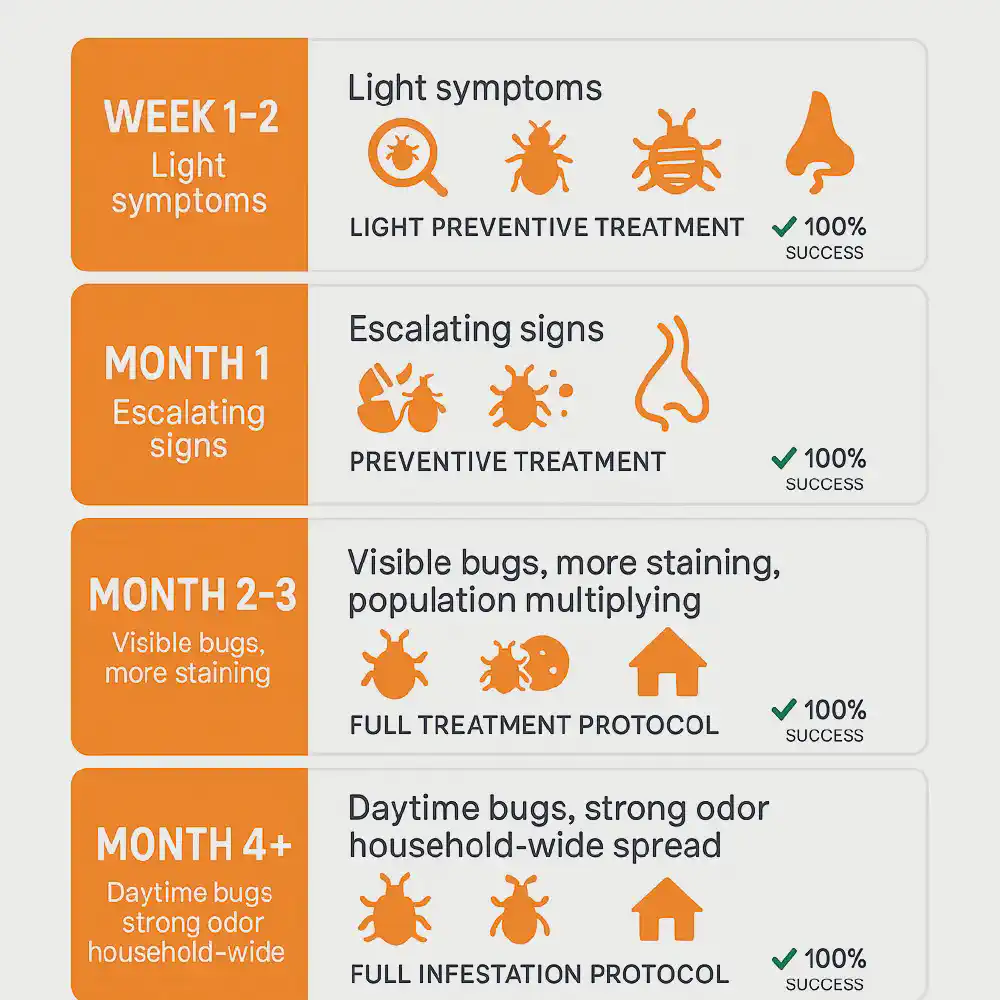
Treatment Timing Importance
Whether you’ve just noticed the first signs or are months into an infestation, full elimination is possible without hiring an exterminator. Our system replicates the exact steps and materials used by pest control companies — with clear instructions, proven treatment kits, and AI-guided support.
| Infestation Age | Treatment Approach | Success Rate (Using Our Protocol) |
|---|---|---|
| Week 1–2 | Light preventive + targeted treatment | 100% success |
| Month 1 | Room-level application, repeat monitoring | 100% success |
| Month 2–3 | Full infestation cycle protocol | 100% success |
| Month 4+ | Persistent zone treatment + retreat follow-up | 100% success (if all steps followed) |
Act fast — confirm & get a plan
Upload what you found; we’ll verify presence and email next steps.
Want advice before uploading?
Describe your situation — we’ll outline the safest immediate moves.
Frequently Asked Questions
Frequently Asked Questions
What do bed bugs look like to the naked eye?
Adult bed bugs are reddish-brown, oval-shaped insects about the size of an apple seed (4-5mm long). They're visible to the naked eye and become darker and more swollen after feeding on blood. See our detailed visual guide.
How can I tell if small bugs are bed bugs or something else?
Bed bugs have distinctive flat, oval bodies with 6 legs, short antennae, and no wings. Unlike fleas, they don't jump, and unlike ticks, they have segmented bodies with a more uniform brown color.
Where should I look first when checking for bed bugs?
Start with mattress seams, box spring corners, and bed frame joints. Check along the headboard, in nearby furniture cracks, and behind picture frames within 8 feet of the bed.
What does bed bug evidence look like on sheets?
Look for small dark or rust-colored stains (fecal spots), reddish or dark blood stains, sweet musty odors, and small brown shed skins or eggshells along mattress seams.
Are baby bed bugs visible without magnification?
Newly hatched bed bugs (1st instar nymphs) are very small (1.5mm) and nearly transparent, making them difficult to see. 2nd-5th instar nymphs are progressively larger and easier to spot.
How do I know if I have a serious bed bug infestation?
Signs of heavy infestation include strong sweet musty odors, numerous blood and fecal stains, multiple live bugs visible during daytime, and extensive bite patterns on multiple family members.
Can bed bugs be colors other than brown?
Unfed bed bugs are light brown to reddish-brown. After feeding, they become darker red or mahogany colored. Nymphs start nearly transparent and darken with each molt and feeding.
What's the difference between bed bug bites and flea bites?
Bed bug bites typically appear in lines or clusters on exposed skin and develop over 1-3 days. Flea bites are usually around ankles/feet, appear immediately, and are more randomly distributed.
How long does it take to confirm a bed bug identification?
With our free AI tool, identification takes just minutes after uploading photos. Traditional visual inspection can take 30-60 minutes and may still leave uncertainty about findings.
Do bed bugs only live in beds and bedrooms?
While beds are preferred, bed bugs live anywhere humans rest regularly - couches, recliners, office chairs, movie theaters, and hotels. They're found within 8 feet of sleeping/resting areas.
What do bed bug eggs look like and where are they found?
Bed bug eggs are tiny (1mm), pearl-white, and shaped like rice grains. They're found in clusters along mattress seams, furniture joints, and protected cracks near resting areas.
How can I tell bed bug droppings from other insect waste?
Bed bug fecal spots are dark brown to black, about the size of a period mark, and often appear in clusters. They may smear when wiped and are typically found along travel paths and hiding spots.
Is it possible to have just one bed bug?
While possible, bed bugs reproduce quickly and live in groups. Finding one usually indicates others are present. Pregnant females can establish new infestations, so immediate action is crucial.
How accurate is the free AI identification tool?
Our AI tool matches professional pest control accuracy (95%+) by analyzing the same visual characteristics experts use - size, color, body structure, and behavioral evidence patterns.
What should I do immediately after confirming bed bugs?
Document evidence with photos, avoid moving infested items, start treatment planning immediately, and consider our professional-grade DIY treatment systems for cost-effective elimination.
How long can bed bugs survive without feeding?
Depending on their life stage and environment, bed bugs can live from several weeks to over a year without a blood meal. Cooler temperatures extend their survival time significantly. [See full survival timeline here.](https://bedbugtreatmentkit.com/blog/how-long-can-bed-bugs-live-without-host/)
Take Action: Get Professional Confirmation Today

Don’t let uncertainty keep you awake at night. Whether you’ve found a suspicious bug or noticed unexplained evidence, our free detection tool provides the professional confirmation you need to move forward with confidence.
What You Get With Our Free Service
Professional identification within minutes - Upload your photos and receive detailed analysis faster than scheduling any appointment.
Species confirmation with confidence rating - Get exact identification results explaining what you’re dealing with, how certain we are, and what it means for your situation.
Custom action plan if bed bugs confirmed - Receive personalized next steps based on your specific situation, including whether DIY treatment is appropriate or professional help is needed.
Complete treatment guidance - Direct access to our specialized treatment protocols, product recommendations, and prevention strategies.
Why Choose Our Detection Service?
- Always available - Upload photos anytime, day or night, and receive results within minutes
- Matches professional accuracy - 95%+ identification rate using the same criteria pest control experts use
- Completely private - No strangers in your home, photos analyzed confidentially
- No obligation - Completely free analysis with no hidden fees or requirements
- Immediate answers - Stop wondering and get definitive identification right now
Remember: Early Identification Changes Everything
- Week 1 identification: Simple, manageable treatment with 85% DIY success rate
- Month 2 identification: More complex but still DIY-friendly with proper guidance
- Month 4+ identification: Often requires expensive professional intervention
The difference between catching bed bugs early and dealing with a full infestation can be thousands of dollars and months of treatment. Take action today while accurate identification can lead to the most effective and affordable treatment options.
Don’t wait another night wondering. Get the professional confirmation you need to sleep soundly again: Start Your FREE Analysis Now
Worried About Bed Bugs? Find Out Now – For Free!
Upload a picture and get instant, free detection. No guessing—just fast, accurate results. If bed bugs are found, we’ll recommend the right products and simple step-by-step treatment.
Click here to start – it’s 100% free!
Get started nowWorried About Bed Bugs? Find Out Now – For Free!
Upload a picture and get instant, free detection. No guessing—just fast, accurate results. If bed bugs are found, we’ll recommend the right products and simple step-by-step treatment.
Click here to start – it’s 100% free!
Get started now